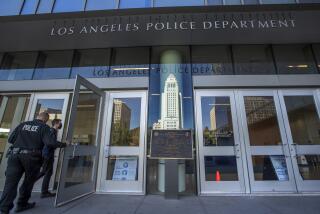Federal report largely backs Darren Wilson in Ferguson police shooting case
After months of investigation, the Justice Department report on the shooting of Michael Brown in Ferguson, Mo., last year largely sides with police Officer Darren Wilson and the much-maligned St. Louis County grand jury that declined to charge him.
The evidence backs Wilson’s claim that he shot Brown in self-defense, the investigation concluded. Physical evidence, including blood trails and DNA, supports Wilson’s testimony that Brown initially tried to grab his gun, was coming toward him when the officer shot and did not have his hands up, as some witnesses had asserted.
The department separately concluded that the Ferguson police department had engaged in repeated racist practices over the years, including excessive force against African Americans.
But in the case of what Justice Department officials called “the horrifying death of a young man,” the investigation found that the evidence backed up Wilson and discredited witnesses who had challenged his story, according to a report of its findings that the department released Wednesday.
Wilson knew about a report of a theft from a Ferguson market and a description of the thieves, which matched Brown and a friend who was with him, the investigators found. That point is important because it means that Brown was not stopped simply for walking in the middle of the street.
Wilson testified before the grand jury that after he accosted the two men and told them to get on the sidewalk, he and Brown struggled through the window of the police cruiser.
Wilson told authorities that he and Brown fought over the officer’s gun and Wilson fired, hitting Brown’s hand. Brown and his friend, Dorian Johnson, fled, and Wilson pursued, the officer testified.
Physical evidence, including bruises on the officer’s jaw and scratches on his neck, as well as Brown’s DNA on Wilson’s collar and his hand, all corroborated that account, the report said.
“Prosecutors could not credit” accounts of witnesses who told a different story because they were “inconsistent with physical and forensic evidence,” the report said.
In what Justice Department said was its other key finding, the investigation determined that after Brown initially ran away from Wilson, he turned around and was moving toward him when the officer fired the fatal shots.
“Several witnesses stated that Brown appeared to pose a physical threat to Wilson as he moved toward Wilson,” the report noted.
“There is no evidence upon which prosecutors can rely to disprove Wilson’s stated subjective belief that he feared for his safety,” it concluded.
The trail of Brown’s blood on the roadway and the most reliable witnesses both supported the conclusion that Brown was heading for Wilson when the officer fired, the report said.
Witnesses who claimed Brown was shot in the back were discredited by the autopsies of Brown, the investigators concluded. Those who said he was running away while shot were discredited by the physical evidence and by contradictions in their own testimony.
Although several witnesses said that Brown was holding up his hands in a gesture of surrender when he was shot, some of those witnesses recanted their versions while others changed their accounts over time. Still others told accounts that were inconsistent with the evidence, the report concluded.
The account of Brown’s raised arms became the rallying cry for demonstrators in Ferguson and elsewhere: “Hands up, don’t shoot.”
But the Justice Department investigation said no credible witnesses supported the account that Brown was trying to surrender.
The physical evidence does not support a claim that Wilson’s use of force was unreasonable, investigators found.
“The only possible basis for prosecuting Wilson ... would therefore be if the government could prove that his account is not true,” the report said.
“Not only do eyewitnesses and physical evidence corroborate Wilson’s account, but there is no credible evidence to disprove Wilson’s perception that Brown posed a threat to Wilson as Brown advanced toward him,” it concluded.
Follow @latimesmuskal and @timphelpsLAT for national news.
More to Read
Sign up for Essential California
The most important California stories and recommendations in your inbox every morning.
You may occasionally receive promotional content from the Los Angeles Times.












